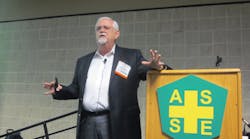Safety 2014: Is the Traditional Safety Management Model Working in Your Organization?
Author and consultant Terry Mathis opened his breakout session at ASSE's 2014 Professional Development Conference and Expo in Orlando, Fla., by declaring: “All progress begins with thinking differently.” Then he challenged EHS professionals to think about whether the traditional model of safety management is producing the results they’re seeking in their organizations.
In the traditional safety management model, Mathis explained, the safety department manages safety, while the production department manages production – with varying levels of cooperation, overlap and continuity between the two areas.
“A lot of companies have been growing that continuity over years, and they’ve gotten really good at it,” Mathis explained. “In other companies, safety and production battle each other. They are enemies. They are dichotomous, opposite choices you can make.”
More Mathis: "When Site Managers Undo Corporate Safety"
While the traditional separation of safety and production might be well-suited for “a tremendously technical, multifaceted organization” that puts a premium on specialization, Mathis asserted that there are a number of disadvantages to the traditional model:
- It emphasizes control over culture – “When you have one person controlling production, and another person trying to control safety, are you really creating a culture in which people are empowered to do what they need to do to do their jobs anyway, or are you trying to micromanage them from two different angles?” Mathis asked the audience.
- It creates dichotomies – Based on his discussions with thousands of plant-floor workers, Mathis has come to the conclusion that most workers think of safety as the opposite sides of a coin. The coin can be flipped to the safety side or to the production side, but it’s impossible to get both sides at the same time. “What a horrible way to do business,” Mathis said. “What a terrible mindset to create.”
- It lets production off the hook – When safety and production are separate, it lets a supervisor or foreman pass the buck on safety. “He can say, ‘Well just get the stuff out the door, and if somebody asks a question about safety, we'll ask the safety guy when he comes around.’”
- It distracts safety from its support role – Safety managers are too busy dousing fires to serve as strategic thinkers, planners and resources for the company.
“Do you know how many safety professionals that I talk to on a regular basis who are running themselves crazy putting out fires because they’re trying to manage safety rather than run safety?” Mathis said. “They’re working in safety rather than working on safety.”
Supervisors as Safety Leaders
For EHS professionals who are using the traditional model of safety management and aren’t getting the results they’re seeking, Mathis offered several ideas, including creating a coaching culture and redefining roles, responsibilities and results (RRR’s).
A coaching culture, Mathis explained, is one in which “the leaders are trying to help the followers become better.” In such an environment, the role of safety leaders is to coach safety-improving behaviors and culture-building behaviors, he said.
“Being successful is more than being a great leader,” he said. “Being successful is leading great people. And you very seldom hire great people off the street. You hire people with the potential for greatness, and you have to make them great after you get them there.”
Setting clear expectations by redefining an organization’s RRR’s can help engender a coaching culture, integrate safety into production and shift safety into more of a support role, Mathis asserted.
Although it’s “a massively oversimplified example,” Mathis said an organization could redefine the RRR’s of front-line supervisors or foremen to make them the everyday safety leaders of their respective work groups. That means they not only would “take the daily lead in safety” but also would need to become “a great personal example of safety,” he explained.
“We need you to walk the talk out there,” Mathis said, describing the way an employer might explain the new marching orders to a supervisor or foreman. “You need to become a safety expert on what your crew does. We know you’re not going to get there overnight. We know you’re not going to be perfect. And we have a resource for you: It’s that guy who used to come around and do the safety part of your job.
“When your workers have a safety question, we want them to come to you first. If you don’t have the answer, you have that resource that you can go back to. But we want you to become the intermediary in that.”
Along the same lines, Mathis recalled a conversation in which a senior executive told him he’d like to see all workers become safety experts on their jobs. For example, a welder would become a safety expert on welding, a machinist would become a safety expert on machining, and so forth.
“That’s one of the smartest things I’ve heard a senior-level executive say to me in a long time,” Mathis said.
How, then, should the RRR’s of safety managers change?
“You would tell your safety manager: ‘I don't want you to be a field manager, a foreman, a supervisor out there. I want you to be a subject-matter expert,’” Mathis explained. “‘I want you to stay up to date on your field. I want you to go to professional development [conferences]. I want you to proactively analyze and strategically plan how we’re going to get better in safety, not run around putting out fires. You need to be a resource for the supervisors.’”
Ideally, safety professionals would teach supervisors how to coach safety, and supervisors would teach workers how to be safe and how to coach safety – creating “a continuous-improvement chain that reinforces itself everywhere along the way.”
